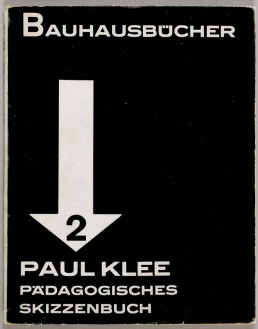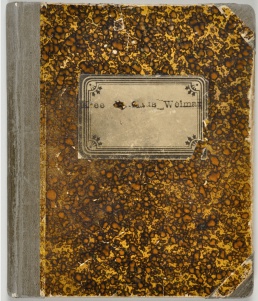Paul Klee
Paul Klee (1879–1940) was a painter whose highly individual style was influenced by movements in art that included expressionism, cubism, and surrealism. He was also a student of orientalism.
Contents
Chronology
Sourced from Moderna Museet, Stockholm, 2016.
- 1879 Paul Klee is born on 18 December in Münchenbuchsee outside Bern in Switzerland. His father is a music teacher, Hans Wilhelm Klee (1849–1940), and his mother a singer, Ida Marie (1855–1921), née Frick. Since his father is German, Klee is automatically a German citizen, according to Swiss law.
- 1898 Moves to Munich to study art. Begins keeping a diary, and continues to do so until 1918.
- 1901-02 Goes on a study trip to Italy. On returning to Bern, he works as a concert violinist.
- 1905 Visit Paris together with the painter Louis Moilliet (1880–1962) and the writer Hans Bloesch (1878–1945).
- 1906 Marries the concert pianist Lily Stumpf (1876–1946). Moves to Munich.
- 1907 Their son Felix (1907–1990) is born. Klee stays at home with his son while his wife works.
- 1910 Klee’s first solo exhibition opens in Bern and tours to three other cities in Switzerland.
- 1911 Starts cataloguing his works. Co-founds the artist organisation Sema. Meets the artists August Macke (1887–1914), Franz Marc (1880–1916), Alexei von Jawlensky (1864–1941), Gabriele Münter (1877–1962) and Wassily Kandinsky (1866–1944), and joins the editorial team of Almanach Der Blaue Reiter that winter.
- 1912 Shows prints in Der Blaue Reiter’s second exhibition. Travels to Paris and encounters cubist works and Robert Delaunay’s (1885–1941) abstract colour compositions. In May, the Blaue Reiter calendar is issued, a publication intended as "a forum for the new ambition that is now emerging in all fields of art, of which the fundamental tendency is: to expand the prevailing boundaries for artistic ability."
- 1913 Commissioned to translate Delaunay’s essay "Light" into German. Klee adopts the ideas expressed in this essay for his own art.
- 1914 Travels with August Macke and Louis Moilliet to Tunisia, where he begins to consider himself an artist for the first time. Co-founder of the artist association Neue Münchener Secession.
- 1916 Drafted into the army.
- 1917 Transferred in January to administrative duties in Gersthofen, where he is able to paint in his spare time. His art sells well, and he is referred to as one of the best German artists.
- 1918 Released from military service in November and returns to Munich.
- 1919 Joins the editorial team of the art publication Münchener Blätter. The art dealer Hans Goltz (1873–1927) was given exclusive rights to sell Klee’s works.
- 1920 Klee is selling well. Goltz organises a major retrospective exhibition of 362 of his works. Two monographs are published, with diary entries provided by Klee. In October, he is offered a position at the Staatliches Bauhaus.
- 1921 Begins teaching at the Bauhaus in Weimar as a design master in the book binding workshop.
- 1922 Appointed master of the metal workshop and later of the coloured glass workshop. Resumes his friendship with Kandinsky when the latter begins teaching at the Bauhaus.
- 1923 Exhibits 270 works in Berlin.
- 1924 His first exhibition in the USA. Holds his lecture On Modern Art, which is published several years later.
- 1925 The Bauhaus moves from Weimar to Dessau. Klee publishes his Pedagogical Sketchbook. His contract with Goltz terminates with a major exhibition. Signs a new contract with the art dealer Alfred Flechtheim (1878–1937). Presents is works in Paris for the first time, winning great accolade among the surrealists.
- 1926 The family moves to a two-family house in Dessau designed by Walter Gropius. They share the house with Nina and Wassily Kandinsky.
- 1927 Takes over as master of textile composition, and teaches painting together with Kandinsky.
- 1928 Visits Egypt towards the end of the year.
- 1929 Will Grohmann (1887–1968) publishes his monograph on Klee.
- 1930 Solo exhibition at the Museum of Modern Art in New York.
- 1931 Resigns from the Bauhaus when it grows harder to combine teaching with his work as an artist. Begins teaching at the Düsseldorf Academy of Fine Art in the autumn.
- 1933 An official persecution of Klee is launched by the new Nazi regime. His art is classified as degenerate. He is banned from working as an artist and loses his job as a teacher at the Academy in Dusseldorf on 21 April. 102 of his works are confiscated from museums in Germany. Klee moves with Lily to Dusseldorf. Signs a contract with Daniel-Henry Kahnweiler in Paris. Emigrates to Switzerland with his family in December.
- 1934 Settles in Bern.
- 1935 Suffers from scleroderma, an autoimmune disease. One of the symptoms is that he has difficulties swallowing.
- 1937 A few of his confiscated works feature in the exhibition Entartete Kunst in Munich.
- 1938 Enigmatic, gloomy signs appear in his paintings, for instance in Yet Another Dark Messenger and Monument to an Animal.
- 1939 Creates a series of pictures of angels.
- 1940 Klee’s father dies. Paul Klee dies as a result of scleroderma in Lucerne on 29 June, shortly before being granted Swiss citizenship.
Publications
- Pädagogisches Skizzenbuch, Munich: Albert Langen, 1925, 50 pp. (German)
- Pedagogical Sketchbook, intro. & trans. Sibyl Moholy-Nagy, New York: Frederick A. Praeger, 1953, 65 pp; 1960. (English)
- Παιδαγωγικό Σημειωματάριο, trans. Β. Λαγοπούλου, Πανας [Panas], 1976. (Greek)
- Pedagogikheskie eskizy, trans. N. Druzhkovoy, 2005. (Russian)
- Über die moderne Kunst, Bern-Bümpliz: Benteli, 1945, 53 pp, DNB. Lecture given at the opening of an exhibition at the Museum in Jena on 26 January 1924. (German)
- On Modern Art, trans. Paul Findlay, London: Faber and Faber, London, 1948, 56 pp. (English)
- Modern Sanat Üzerine, trans. Rahmi G. Öğdül, Altikirkbes Yayin, 1995; 2002; 2007. (Turkish)
- Das bildnerische Denken, ed. Jürg Spiller, Basel: Schwabe, 1956. (German)
- Paul Klee Notebooks, Vol. 1: The Thinking Eye, trans. Ralph Manheim, London: Lund Humphries, 1961. (English)
- Gedichte, Zurich: Arche, 1960. (German)
- Some Poems, trans. Anselm Hollo, Scorpion Press, 1962, 35 pp. (English)
- The Diaries of Paul Klee 1898–1918, ed. Felix Klee, Berkeley: University of California, 1964. (English)
- Unendliche Naturgeschichte, ed. Jürg Spiller, Basel: Schwabe, 1970. (German)
- Paul Klee Notebooks, Vol. 2: The Nature of Nature, trans. Heinz Norden, London: Lund Humphries, 1973. (English)
- Schriften, Rezensionen und Aufsätze, ed. Ch. Geelhaar, Cologne, 1976. (German)
- Čáry, trans. Ivan Wernisch, Prague: Odeon, 1990, 172 pp. Poems. (Czech)
More texts (on Wikisource-DE)
Manuscripts
- Beiträge zur bildnerischen Formlehre, [Nov 1921-Dec 1922], [192] pp. A book of lectures and exercises made while teaching at Bauhaus; kept in Zentrum Paul Klee, Bern. Facsimile ed. with transcriptions published as Beiträge zur bildnerischen Formlehre. Faksimile des Originalmanuskripts von Paul Klees erstem Vortragszyklus am Bauhaus Weimar 1921/22, ed. Jürgen Glaesemer, Paul-Klee-Stiftung, 1979, 190 pp; repr., 1999.
- Bildnerische Gestaltungslehre, [1923-31], [c3900] pp. A collection of loose manuscript pages of notes and sketches made while teaching at Bauhaus; kept in Zentrum Paul Klee, Bern. (German)
Catalogues
- Paul Klee, Berlin: Der Sturm, [1918], [24] pp. 22 works from 1913-16.
- Paul Klee, 1879-1940: A Retrospective Exhibition, intro. Will Grohmann, New York: The Solomon R. Guggenheim Museum, 1967. (English)
- Paul Klee -- The Bauhaus Years: Works from 1918-1931, New York: Dickinson Roundell, 2013, 103 pp. With essays by Olivier Berggruen and Rémi Labrusse. (English)
- Paul Klee: Bauhaus Master, Madrid: La Fábrica/Fundación Juan March, 2013, 285 pp. A selection of 137 works from 1899-1940, ca. 100 handwritten notes selected from classes Klee gave at the Bauhaus, and an array of archival objects and documents. [1] [2] (English)
- Paul Klee: maestro de la Bauhaus, Madrid: La Fábrica/Fundación Juan March, 2013, 285 pp. [3] (Spanish)
- Klee/Aguéli, Stockholm: Moderna Museet, 2016. [4] (Swedish)
Literature
- Leopold Zahn, Paul Klee: Leben, Werk, Geist, Potsdam: Gustav Kiepenheuer, 1920. (German)
- Herbert Edward Read, Surrealism, Scholarly Press, 1936. (English)
- Nika Hulton, An Approach to Paul Klee, Phoenix House, 1956. (English)
- James Smith Pierce, Paul Klee and Primitive Art, Garland, 1976 (English).
- Pierre Boulez, Le pays fertile. La musique de Paul Klee, Gallimard, 1989. (French)
- Il paese fertile. Paul Klee e la musica, trans. Guillemette Denis, Milan: Leonardo, 1990, 181 pp. (Italian)
- Marcel Franciscono, Paul Klee: His Work and Thought, Chicago: University of Chicago Press, 1991.
- Regine Prange, Das Kristalline als Kunstsymbol. Bruno Taut und Paul Klee: zur Reflexion des Abstrakten in Kunst und Kunsttheorie der Moderne, Hildesheim: Olms, 1991, 511 pp. (German)
- Annie Bourneuf, Paul Klee: The Visible and the Legible, University of Chicago Press, 2015, 256 pp. [5] (English)
Documentaries
- Paul Klee – Die blaue Glut, dir. Birgitta Ashoff, 45 min, 2004. (German)
- Paul Klee. Die Stille des Engels, dir. Michael Gaumnitz, 52 min, 2005. (German)
- Die Tunisreise. Auf den Spuren von Paul Klee, dir. Bruno Moll, 76 min, 2007. (German)

